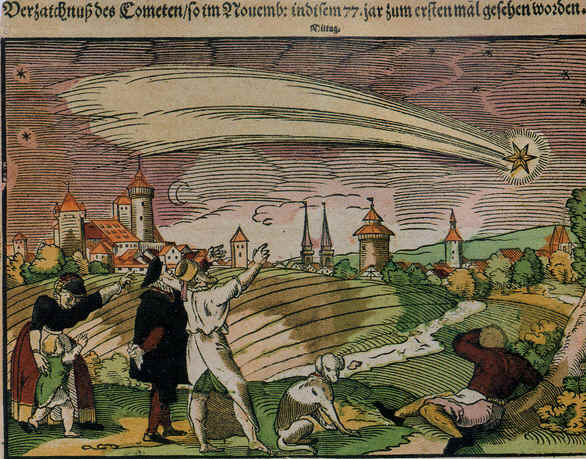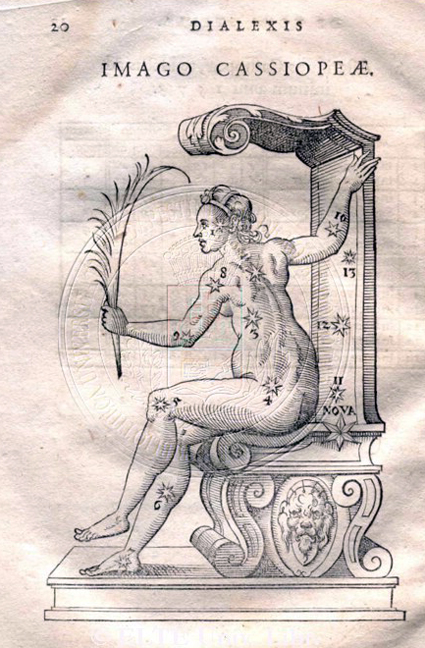|
Tycho Brahe |
Astronomiae instauratae progymnasmata, Uraniburgi 1610 De
nova et nullius śvi memoria prius visa Stella, iam pridem Anno ŗ nato
CHRISTO 1572, mense Novembrj primým Constecta, contemplatio matematica,
Hafniae 1573 Tychonis Brahe ... Epistolarum astronomicarum libri: quorum primus hic ... principis Gulielmi Hassiae landgravii ac ipsius mathematici literas, unaq[ue] responsa ad singulas complecitur, Noribergae : apud Levinum Hulsium ..., 1601 Tychonis
Brahe Astronomiae Instauratae Mechanica, Noribergae, apud Levinvm Hvlsivm.
Anno M. DCII De mundi aetherei recentioribus phaenomenis liber secundus de cometa anni 1577, Pragae Bohemiae 1603 |
Tycho Brahe
Sulla vita e le opere di
Ticho Brahe propongo la lettura della voce a lui dedicata nellíedizione
inglese di Wikipedia, http://en.wikipedia.org/wiki/Tycho_Brahe
dalla quale estraggo il
seguente periodo dedicato alla scoperta della Nova in Cassiopea osservata
dallíastronomo lí11 novembre 1572:
The
1572 supernova
On 11 November 1572,
Tycho observed (from Herrevad
Abbey) a very bright star, now named SN
1572, which had unexpectedly appeared in the constellation Cassiopeia.
Because it had been maintained since antiquity that
the world beyond the Moon's orbit was eternally unchangeable (celestial
immutability was a fundamental axiom of the Aristotelian world-view),
other observers held that the phenomenon was something in the terrestrial sphere
below the Moon. However, in the first instance Tycho observed that the object
showed no daily parallax against
the background of the fixed stars. This implied it was at least farther away
than the Moon and those planets that do show such parallax. He also found the
object did not change its position relative to the fixed stars over several
months as all planets did in their periodic orbital motions, even the outer
planets for which no daily parallax was detectable. This suggested it was not
even a planet, but a fixed star in the stellar sphere beyond all the planets. In
1573 he published a small book, De nova stella thereby coining the term nova for
a "new" star (we now classify this star as a supernova and
we know that it is 7500 light-years from
Earth). This discovery was decisive for his choice of astronomy as a profession.
Tycho was strongly critical of those who dismissed the implications of the
astronomical appearance, writing in the preface to De nova stella: "O
crassa ingenia. O caecos coeli spectatores" ("Oh thick wits. Oh blind
watchers of the sky").
Tycho's discovery was the
inspiration for Edgar
Allan Poe's poem "Al
Aaraaf". In 1998, Sky
& Telescope magazine published an article by Donald W. Olson,
Marilynn S. Olson and Russell L. Doescher arguing, in part, that Tycho's
supernova was also the same "star that's westward from the pole" in
Shakespeare's Hamlet.
Le tavole seguenti che rappresentano Cassiopea e la zona celeste priva del personaggio mitologico sono tratte da Tycho Brahe, Astronomiae instauratae progymnasmata, Uraniburgi 1610 la cui parte principale, che porta il titolo De Nova Stella Anni 1572, Ť dedicata alla Nova. L'intero testo di Astronomiae... cosž come le altre opere presenti in questa scheda, sono proposte per cortesia di E-rara.

Tavole









De
nova et nullius śvi memoria prius visa Stella, iam pridem Anno ŗ nato CHRISTO
1572, mense Novembrj primým Constecta, contemplatio matematica, Hafniae
1573

http://www.archive.org/stream/denovaetnullius00brahgoog#page/n28/mode/2up
La tavola che indica la Nova tra le stelle di Cassiopea

Schema dell'eclisse di Luna del dicembre 1573

Tychonis
Brahe ... Epistolarum astronomicarum libri: quorum primus hic ... principis
Gulielmi Hassiae landgravii ac ipsius mathematici literas, unaq[ue] responsa ad
singulas complecitur, Noribergae : apud Levinum Hulsium ..., 1601










Tychonis Brahe Astronomiae Instauratae Mechanica, Noribergae, apud Levinvm Hvlsivm. Anno M. DCII
Il volume Ť dedicato alla descrizione dell'osservatorio e degli strumenti di osservazione utilizzati dall'astronomo



























De
mundi aetherei recentioribus phaenomenis liber secundus de cometa anni 1577,
Pragae Bohemiae 1603
Il volume Ť dedicato alle osservazioni della cometa del 1577-1578



Schema del modello ticonico geogentrico
alternativo a quello copernicano e a quello aristotelico

e luogo della cometa

altre tavole di strumenti


SULLA COMETA DEL 1577-78 CONSULTA ANCHE
Antologia delle osservazioni di C/1577 V1, la Grande Cometa del 1577

http://www.atlascoelestis.com/cometa%201577%20base.htm
sulla Nova del 1572 leggi
Thaddaeus
Hagecius Ab Hagek (1525-1600)
Imago Cassiopeae in Dialexis de Novae et Prius Incognitae Stellae Inusitatae Magnitudinis, Francofurti ad Moenum, 1574

http://www.atlascoelestis.com/Hagecius%20Pagina.htm
Georg
Busch
Die andere beschreibung von dem cometen/... 1572.

Thomas Digges
Alae
seu scalae mathematicae, quibus visibilium remotissima coelorum theatra
conscendi ... tum hujus portentosi syderis in mundi Boreali plaga ... coruscanti
distantia et magnitudo immensa ... cognosci liquidissime possit, Londra 1573

http://www.atlascoelestis.com/Digges%201573%20base.htm
di FELICE STOPPA
APRILE 2014